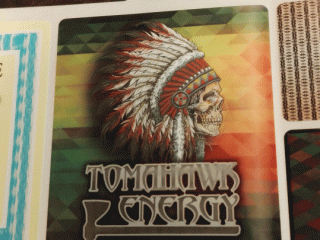“Wait a minute! Did that dog just wink at me?” you ask as you stroll down the aisle of a store. Before you know it, you’ve stopped in your tracks, picked up the item, and spent a minute or two being fascinated with the 3D label. What are the odds of you buying that item based on the label alone? Pretty strong!
Welcome to the revolutionary 3D motion and security labeling technique for flexographic printers.
New advancements in flexographic plate imaging, along with the precision print capabilities of our robust MPS EF press, have opened the door to advanced methods of producing security and 3D motion flexo roll labels. It’s called lenticular printing, known as “flickers,” “tilt cards,” “wiggle pictures,” or like the dog on the label — “winkies.”
Get ready to take your labels and branding to the next level.
What is lenticular printing?
In simple terms, lenticular printing is about creating images that move or show depth using 3D illusion.
Lenticular means relating to lenses, which are called lenticules. These lenticules create the illusion of depth, or the ability to change or move as the image is viewed from different angles. The lenticules focus your sight on different parts of the underlying picture as the printed picture is made up of multiple pictures that are printed in alternating lines.
 Lenticular printing is not a new technique. It has been used in offset printing for years. However, recent extrusion advancements and a major reduction in lenticular film thickness have allowed for an exciting market to emerge for flexographic printers.
Lenticular printing is not a new technique. It has been used in offset printing for years. However, recent extrusion advancements and a major reduction in lenticular film thickness have allowed for an exciting market to emerge for flexographic printers.
Jeff Toepfer from Imageworx explains: “In the USA, lenticular products have been around for decades. Products such as image flip baseball cards, comic book covers, movie posters, and small and large-scale advertisement displays were produced with a sheet-fed offset print process and much thicker, non-flexible, lenticular lens materials.
“Just recently, Imageworx began developing art with brand new roll-fed lens films that conform to the thickness requirements for product wrap and roll-fed dispensing requirements of pressure sensitive labeling.”
Lenticular and labels
The roll-fed lens film uses micro lenses (a technology also used for 3D displays), to magnify printed micro images and show illusion of depth, movement or the ability to change or morph into a new image as the label is viewed from different angles.
What has improved in recent years is the resolution. The vertical lenses per inch on the film are three to five times higher in frequency than a typical lenticular film and are thin enough to be used as a wrap-around label.
With 1:1 linear pixel processing capability down to 2.6 microns and high-resolution Kodak NX plates, Imageworx has developed a design/imaging technique that works in concert with the remarkable resolution capabilities of the Kodak NX plate.
“We were very excited to learn that high resolution lens films were in production,” shared Jeff. “The effects that can be translated through the film are incredibly attractive, and the detailed security images built at Imageworx are nearly impossible to recreate. Our goal was to create designs that draw immediate consumer attention through motion optics, and to develop cost-efficient security brand protection labels to protect the authenticity of highly counterfeited Items.”
The challenge is finding a press that can reproduce the lenticular images correctly.
MPS EF press to the rescue!
Creating lenticular images at high resolution required a printing press that can print a microscopic line with limited impression and dot gain.
Jeff explained: “I’ve seen an ongoing issue with dot gain and over impression when printing high resolution lenticular flexo projects. It’s very important to limit the amount of ink transfer and line thickness gain to produce a desirable result.
“What I found most impressive about the MPS EF series press was that it produced the minimum amount of ink transfer required while maintaining ideal densities, and it was surprisingly able to produce a similar result at both 60 and 200 meters per minute.”
Ready to take your labels and branding to the next level? Visit MPS website for more details and get in touch with us!
For more information about lenticular printing, please contact Jeff Toepfer via email jeff@imageworx.net or www.imageworx.net.